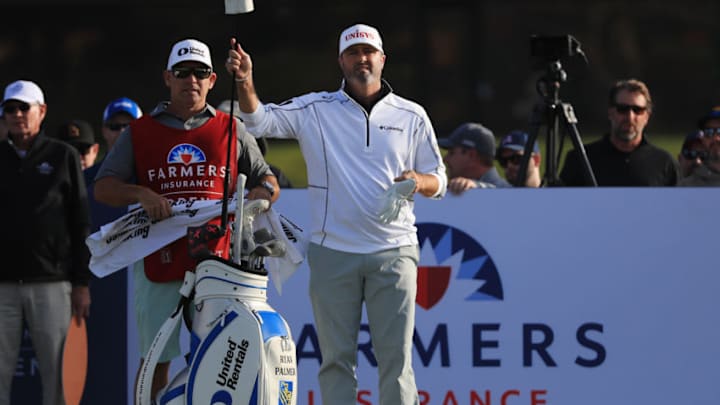Ryan Palmer shot an intensely disappointing 77 to finish the Farmers Insurance Open. Still, he’s on track to make 2020 the best season of a lengthy career
Contrary to what Aesop says, slow and steady doesn’t always win the race. But it can make you a decent living. That approach has clicked recently for Ryan Palmer. Not in championships, but in contentions. At age 43 and a 17-season Tour veteran, Palmer has begun to lose distance off the tee, and he will never rank among the game’s celebrities. Yet he is enjoying his most consistent and enriching season to date. Slow and steady.
Sunday at the Farmers Insurance Open, Ryan Palmer’s closing 77 dropped him from the runner-up position, one stroke behind third-round leader John Rahm, all the way down to a tie for 21st, nine strokes behind the winner, Marc Leishman.
The earnings difference encompassed in that Sunday collapse probably cost Palmer close to three-quarters of a million dollars beyond the $69,000 he walked away with. Even so, Palmer increased his seasonal earnings to $927,000, maintaining a pace that projects 2020 to be the most efficient, and probably most rewarding, season of his career.
More from Pro Golf Now
- Golf Rumors: LIV set to sign Masters Champion in stunning deal
- Fantasy Golf: Grant Thornton Invitational DFS Player Selections
- Brutal return leaves Will Zalatoris looking towards 2024
- Stars You Know at World Champions Cup Starts Thursday at Concession
- Fantasy Golf: An Early Look at the 2024 Masters Tournament
In many ways, Palmer’s six 2020 season starts – taken collectively, embody the optimal case most Tour pros would accept and envision, if not dream about. He hasn’t won, but he also hasn’t missed a single cut, five times landing within the tournament’s top 25. That means he’s walked away with a regular weekly paycheck averaging $154,000.
His performances include a tie for third at the QBE Shootout, a tie for fourth at the Sony Open, and a tie for 10th at the Zozo Championship. In 27 competitive rounds, he’s broken 70 16 times and that 77 collapse Sunday was only his second stumble above 72 all season.
His 69.97 stroke scoring average ranks 17th on Tour, a 39-place jump from his 56th standing of one season ago, which itself represented a 75-place jump from 2018.
Guys aren’t supposed to suddenly get better at age 43, yet that appears to be precisely what Palmer has done. How?
Statistically, the answer appears to lie squarely with his driving game.
Palmer’s 2004 arrival on Tour happens to coincide perfectly with the simultaneous arrival of the Strokes Gained system of player evaluation. He is, then, one of the first players for whom we have a complete and extensive Strokes Gained data set. It is elucidating.
Fundamentally, Strokes Gained measures a player’s aptitude relative to the field in four areas: Off The Tee, Approaching the Green, Around The Green and Putting. Any positive number indicates that the player is above average; negative numbers indicate a skill deficit.
Over the course of his career, Palmer’s approach game numbers have never run higher than +0.56 strokes in 2017 or lower than -0.15 strokes in 2009. The average has been +0.20.
His recovery game has been a consistent weakness, and again a steady one. He peaked at +0.08 Strokes Gained in 2014, cratered to -0.44 in 2007, and has averaged -0.18.
On the greens, Palmer has consistently been average. In 15 of his 17 seasons, he finished between +0.45 and -0.08 Strokes Gained Putting, his career average an almost neutral 0.05.
It’s Off The Tee where Palmer has shown growth and development. During his first decade on Tour, Palmer picked up an average of 0.17 strokes on the field off the tee. Since 2014, that edge has increased to +0.50. So far this season it’s +0.75 strokes.
Here’s the odd thing. When you see a player improving his advantage off the tee, your first instinct is that he must be banging the ball longer. Yet that’s precisely what Palmer isn’t doing.
So far this season Ryan Palmer is averaging 293.5 yards off the tee, a distance that is actually a hair shorter than the 295.6 yards he generated during his first full season on tour in 2004. From a pure distance standpoint, Palmer peaked in 2015, when he averaged 305.2 yards.
Palmer’s increased steadiness appears to flow, rather, from his improved accuracy, an often-overlooked skill on a tour heavily populated with sluggers.
Until this season, accuracy had never been a Palmer asset. He had never bettered the 63.24 percent of fairways hit that he achieved as a rookie in 2004, averaging just 58.97 percent. During the 2019 season, he ranked 120th on tour at 60.67 percent.
Because they often can overpower rough, pros tend to pay only secondary attention to actually hitting fairways, and with good reason. During the 2019 season, the strength of the correlation between a player’s score and the number of fairways he hit was just 17 percent. Unless you were playing a U.S. Open course with six-inch rough, accuracy wasn’t a big deal.
Yet it has become a big deal for Ryan Palmer and judging by the data a shaper of his newfound success. After a career of finding fairways at only a 60 percent rate, Palmer this season is hitting them better than 70 percent of the time, a frequency that has jumped him into the game’s top 25 in that skill.
It was even better than that until this week’s Farmers. Ryan Palmer entered the tournament ranking top 10 in fairway accuracy above 73 percent but found only 57 percent of them at Torrey Pines. En route to his Sunday 77, Palmer hit just seven of 14 fairways.
Still, it was probably his play on and around Torrey’s greens that killed Palmer’s hopes for his fifth career win. He surrendered 3.75 strokes to the field via his putting Sunday, plus another 1.2 strokes around the greens.
